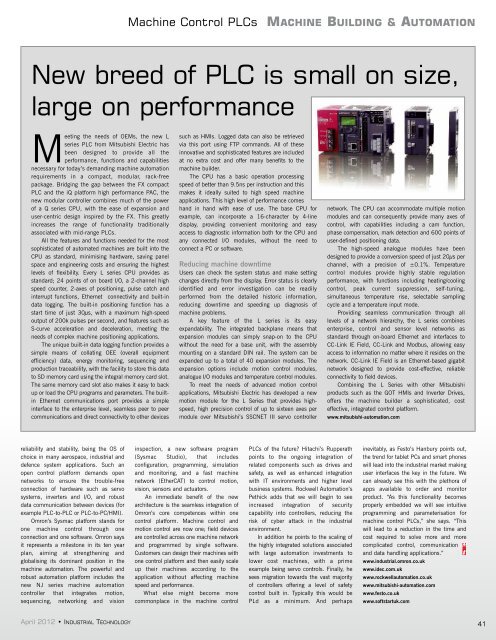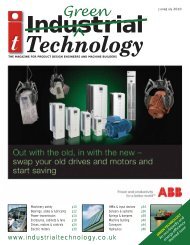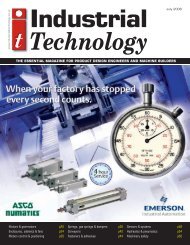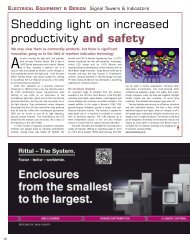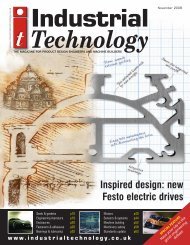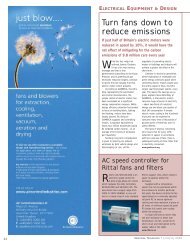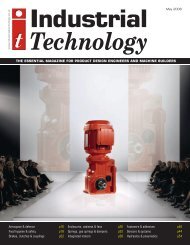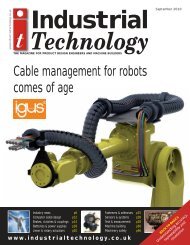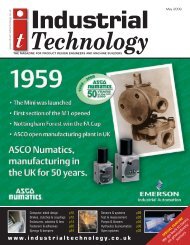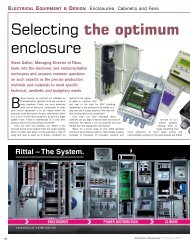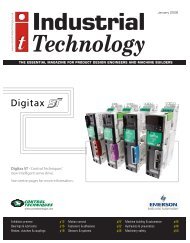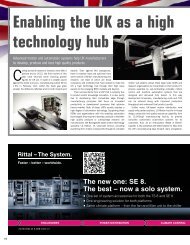machine building & automation - Industrial Technology Magazine
machine building & automation - Industrial Technology Magazine
machine building & automation - Industrial Technology Magazine
- No tags were found...
You also want an ePaper? Increase the reach of your titles
YUMPU automatically turns print PDFs into web optimized ePapers that Google loves.
Machine Control PLCs MACHINE BUILDING & AUTOMATIONNew breed of PLC is small on size,large on performanceMeeting the needs of OEMs, the new Lseries PLC from Mitsubishi Electric hasbeen designed to provide all theperformance, functions and capabilitiesnecessary for today’s demanding <strong>machine</strong> <strong>automation</strong>requirements in a compact, modular, rack-freepackage. Bridging the gap between the FX compactPLC and the iQ platform high performance PAC, thenew modular controller combines much of the powerof a Q series CPU, with the ease of expansion anduser-centric design inspired by the FX. This greatlyincreases the range of functionality traditionallyassociated with mid-range PLCs.All the features and functions needed for the mostsophisticated of automated <strong>machine</strong>s are built into theCPU as standard, minimising hardware, saving panelspace and engineering costs and ensuring the highestlevels of flexibility. Every L series CPU provides asstandard; 24 points of on board I/O, a 2-channel highspeed counter, 2-axes of positioning, pulse catch andinterrupt functions, Ethernet connectivity and built-indata logging. The built-in positioning function has astart time of just 30µs, with a maximum high-speedoutput of 200k pulses per second, and features such asS-curve acceleration and deceleration, meeting theneeds of complex <strong>machine</strong> positioning applications.The unique built-in data logging function provides asimple means of collating OEE (overall equipmentefficiency) data, energy monitoring, sequencing andproduction traceability, with the facility to store this datato SD memory card using the integral memory card slot.The same memory card slot also makes it easy to backup or load the CPU programs and parameters. The builtinEthernet communications port provides a simpleinterface to the enterprise level, seamless peer to peercommunications and direct connectivity to other devicessuch as HMIs. Logged data can also be retrievedvia this port using FTP commands. All of theseinnovative and sophisticated features are includedat no extra cost and offer many benefits to the<strong>machine</strong> builder.The CPU has a basic operation processingspeed of better than 9.5ns per instruction and thismakes it ideally suited to high speed <strong>machine</strong>applications. This high level of performance comeshand in hand with ease of use. The base CPU forexample, can incorporate a 16-character by 4-linedisplay, providing convenient monitoring and easyaccess to diagnostic information both for the CPU andany connected I/O modules, without the need toconnect a PC or software.Reducing <strong>machine</strong> downtimeUsers can check the system status and make settingchanges directly from the display. Error status is clearlyidentified and error investigation can be readilyperformed from the detailed historic information,reducing downtime and speeding up diagnosis of<strong>machine</strong> problems.A key feature of the L series is its easyexpandability. The integrated backplane means thatexpansion modules can simply snap-on to the CPUwithout the need for a base unit, with the assemblymounting on a standard DIN rail. The system can beexpanded up to a total of 40 expansion modules. Theexpansion options include motion control modules,analogue I/O modules and temperature control modules.To meet the needs of advanced motion controlapplications, Mitsubishi Electric has developed a newmotion module for the L Series that provides highspeed,high precision control of up to sixteen axes permodule over Mitsubishi’s SSCNET III servo controllernetwork. The CPU can accommodate multiple motionmodules and can consequently provide many axes ofcontrol, with capabilities including a cam function,phase compensation, mark detection and 600 points ofuser-defined positioning data.The high-speed analogue modules have beendesigned to provide a conversion speed of just 20µs perchannel, with a precision of ±0.1%. Temperaturecontrol modules provide highly stable regulationperformance, with functions including heating/coolingcontrol, peak current suppression, self-tuning,simultaneous temperature rise, selectable samplingcycle and a temperature input mode.Providing seamless communication through alllevels of a network hierarchy, the L series combinesenterprise, control and sensor level networks asstandard through on-board Ethernet and interfaces toCC-Link IE Field, CC-Link and Modbus, allowing easyaccess to information no matter where it resides on thenetwork. CC-Link IE Field is an Ethernet-based gigabitnetwork designed to provide cost-effective, reliableconnectivity to field devices.Combining the L Series with other Mitsubishiproducts such as the GOT HMIs and Inverter Drives,offers the <strong>machine</strong> builder a sophisticated, costeffective, integrated control platform.www.mitsubishi-<strong>automation</strong>.comreliability and stability, being the OS ofchoice in many aerospace, industrial anddefence system applications. Such anopen control platform demands opennetworks to ensure the trouble-freeconnection of hardware such as servosystems, inverters and I/O, and robustdata communication between devices (forexample PLC-to-PLC or PLC-to-PC/HMI).Omron’s Sysmac platform stands forone <strong>machine</strong> control through oneconnection and one software. Omron saysit represents a milestone in its ten yearplan, aiming at strengthening andglobalising its dominant position in the<strong>machine</strong> <strong>automation</strong>. The powerful androbust <strong>automation</strong> platform includes thenew NJ series <strong>machine</strong> <strong>automation</strong>controller that integrates motion,sequencing, networking and visioninspection, a new software program(Sysmac Studio), that includesconfiguration, programming, simulationand monitoring, and a fast <strong>machine</strong>network (EtherCAT) to control motion,vision, sensors and actuators.An immediate benefit of the newarchitecture is the seamless integration ofOmron’s core competences within onecontrol platform. Machine control andmotion control are now one; field devicesare controlled across one <strong>machine</strong> networkand programmed by single software.Customers can design their <strong>machine</strong>s withone control platform and then easily scaleup their <strong>machine</strong>s according to theapplication without affecting <strong>machine</strong>speed and performance.What else might become morecommonplace in the <strong>machine</strong> controlPLCs of the future? Hitachi’s Rupperathpoints to the ongoing integration ofrelated components such as drives andsafety, as well as enhanced integrationwith IT environments and higher levelbusiness systems. Rockwell Automation’sPethick adds that we will begin to seeincreased integration of securitycapability into controllers, reducing therisk of cyber attack in the industrialenvironment.In addition he points to the scaling ofthe highly integrated solutions associatedwith large <strong>automation</strong> investments tolower cost <strong>machine</strong>s, with a primeexample being servo controls. Finally, hesees migration towards the vast majorityof controllers offering a level of safetycontrol built in. Typically this would bePLd as a minimum. And perhapsinevitably, as Festo’s Hanbury points out,the trend for tablet PCs and smart phoneswill lead into the industrial market makinguser interfaces the key in the future. Wecan already see this with the plethora ofapps available to order and monitorproduct. “As this functionality becomesproperly embedded we will see intuitiveprogramming and parameterisation for<strong>machine</strong> control PLCs,” she says. “Thiswill lead to a reduction in the time andcost required to solve more and morecomplicated control, communicationand data handling applications.”www.industrial.omron.co.ukwww.idec.com.ukwww.rockwell<strong>automation</strong>.co.ukwww.mitsubishi-<strong>automation</strong>.comwww.festo.co.ukwww.softstartuk.comApril 2012 • INDUSTRIAL TECHNOLOGY41


